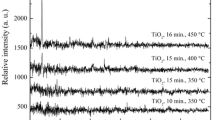Abstract
Single Ionic gas sensor (IGS) was fabricated to measure pressure, humidity and recognizes the gases. Anodic method was used to create TiO2 nanotubes (TNTs) (with internal diameter from 45 to 90 nm) on the surfaces of pure Ti and Ti-6Al-7Nb alloy. Covered surface with TNTs was operated as negative electrode to build high localized electric field and minimize breakdown voltage (V bd). The distance between the electrodes was fixed at 60 μm. Local electric field enhancement β factor was calculated by Fowler–Nordheim plot. Its value was 857 for anodized Ti (ATi). After annealing at 800 °C; TNTs on pure Ti surface transformed to parallel rods with diameters (from 95 to 550 nm). But on alloy surface, TNTs were transformed to protrusions. Sensitivity of measuring pressure for anodized samples decreased with increasing mean free path of testing gases. For all gases; there was increment in Vbd with pressure increasing. For each gas there was specific Vbd at definite pressure and humidity; this value represented a “fingerprint” for each gas recognized it from other gases. Sensitivity of humidity for both anodized and annealed IGSs increased with increasing of relative humidity (%RH). (Vbd, Humidity) curve was approximately linear for annealed Ti and its alloy.











Similar content being viewed by others
References
Abdel-Salam M, Anis H, El-Morshedy A, Radwan R (2000) High Voltage Engineering: Theory and Practice, 2nd edn. Dekker, New York
Al Hilfi M, Alzubaydi T, Mali S (2013) Corrosion characterisation of medical alloys modified by forming titanium nanotubes via anodic oxidation and annealing process. J Mater Technol 28(6):297–304
Emanuela S, Fedor F, Maria N, Margitta U et al (2012) Ti6Al7Nb surface modification by anodization in electrolytes containing HF. UPB Sci Bull Series B 74(2):277–288
Huang J, Li M, Huang Z, Liu J (2007) A novel conductive humidity sensor based on field ionization from carbon nanotubes. Sens Actuators, A 133:467–471
Kim S (2006) CNT sensors for detecting gases with low adsorption energy by ionization. Sensors 6(5):503–513
Liang B, Ogino A, Nagatsu M (2010) Journal of physics. D, Applied physics. 43:275202
Metikoš-Hukovič M, Wokal K, Piljac J (2003) The influence of niobium and vanadium on passivity of Ti-based implants in physiological solution. Biomaterials 24:3765–3775
Modi A, Koratkar N, Lass E, Wei, Ajayan P (2003) Miniaturized gas ionization sensors using carbon nanotubes. Nature 424:171–174
Poudel B, Wang WZ, Dames C, Huang JY, Kunwar S, Wang DZ, Banerjee D, Chen G, Ren ZF (2005) Formation of crystallized titania nanotubes and their transformation into nanowires. Nanotechnology 16(9):1935–1940
Qingyun C, Lixia Y, Yan Y (2006) Investigations on the self-organized growth of TiO2 nanotube arrays by anodic oxidization. Thin Solid Films 515:1802–1806
Rafal T, Zbigniew Z, Lech P, Jerzy Z (2007) Effect of conditioning on field electron emission of suspension plasma sprayed TiO2 coatings. Vacuum 81:1278–1282
Ramin, B., Necoleta, Ch., Mojtaba, K.,(2009) Subtorr operation of a miniature gas ionization sensor based on gold nanowires. Sensors and materials.21(1),53–64
Rui L, Wein-Duo Y, Liang-Sheng Q, Jian-Fu W (2011) Fabrication of TiO2 nanotube arrays by electrochemical anodization in an NH4F/H3PO4 electrolyte. Thin Solid Films 519:6459–6466
Sadeghian B, Kahrizi M (2007) A novel miniature gas ionization sensor based on freestanding gold nanowires. Sensors Actuators A 137:248–255
Sadeghian B, Kahrizi M (2008) A novel gas sensor based on tunneling-field-ionization on whisker-covered gold nanowires. IEEE Sens J 8(2):161
Varghese O, Grimes C (2003) Metal oxide nano architectures for environmental sensing. J Nanosci Nanotechnol 3(4):277–293
Verma N, Singh S, Srivastava R, Yadav B (2014) Fabrication of iron Ti oxide thin film and its application as opto-electronic humidity and liquefied petroleum gas sensors. Opt Laser Technol 57:181–188
Wang H, Zou C, Tian C, Zhou L, Wang Z, Fu D (2011) A novel gas ionization sensor using Pd nanoparticle-capped ZnO. Nanoscale Res Lett 6:534–538
Wei Wang Ch, Sheng RG, Chen JB, Li Y, Wang J (2009) Field emission from TiO2/Ti nanotube array films modified with carbon nanotubes. J Korean Phys Soc 55(6):2662–2666
Wei H, Chang YH, Chen Ch (2012) Facile fabrication of TiO2 nanorod arrays for gas sensing using double-layered anodic oxidation method. J Electrochem Soc 159(1):K5–K9
Wu J, Liu H, Wang Y, Xu D, Yafei Z (2008) A MEMS-based ionization gas sensor using carbon nanotubes and dielectric barrier. Proc. of the 3rd IEEE Int. Conf on Nano/Micro Engineered and Molecular System, Sanya, China, p 824
Yadav B, Yadav R, Dwivedi P (2010) Sol–gel processed (Mg–Zn–Ti) oxide nano composite film deposited on prism base as an opto-electronic humidity sensor. Sensors Actuators B 148:413–419
Author information
Authors and Affiliations
Corresponding author
Rights and permissions
About this article
Cite this article
AlHilfi, M.S., Khaleel, R.S. Fabrication of Gas Ionization Sensor to Recognize Gases and Measure Pressure and Humidity. Iran J Sci Technol Trans Sci 42, 181–189 (2018). https://doi.org/10.1007/s40995-017-0234-9
Received:
Accepted:
Published:
Issue Date:
DOI: https://doi.org/10.1007/s40995-017-0234-9




